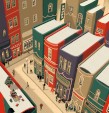Siddharth Ramakrishnan, a neuroscientist, professor of biology at the University of Puget Sound, and tarot reader since 2000, explores what goes on in our brains when we look at images on tarot cards or other symbols and why we interpret things the way we do in The Neuroscience of Tarot: From Imagery to Intuition to Prediction (Llewellyn, Nov.).
The topic of intuition is very important to tarot diviners, according to Barbara Moore, acquisitions editor at Llewellyn. “For too many years, we’ve operated under this notion that intuition is the first thing that pops into your head,” she says. “Through understanding how the brain makes connections, we can learn to control or mitigate the biases and prejudices that cloud our intuition. The information and the exercises in this book help us nurture intuition so that it is more robust and more reliable.”
By examining intuition from a scientific perspective, Ramakrishnan says, readers can learn how to strengthen the brain’s powers while also getting to know themselves better. “It’s all about how we make decisions and deal with emotions.”
How did the idea originate to apply neuroscience to tarot?
A lot of questions people face when they go in for a tarot reading are about why am I feeling this way, what choices do I have, or what do I do next. A lot of it is concerned with making decisions, dealing with emotions, and looking at choices—which have to do with how to bring on a behavior. So, I was thinking that the brain must be connected somehow, and I was inspired to make that connection.
You define intuition as “acquiring knowledge without any conscious notion, proof, logic, or evidence of that knowledge,” and divination is defined as “extraordinary intuition or unusual insight.” These exclude clairvoyance. Why?
There is no hard science behind fortune-telling, and at this point in time, we cannot say much about the fortune-telling aspect of things. There is a difference between intuition and psychic ability. I wanted to make that distinction. Intuition is not grabbing information from the universe per se, but rather from within.
What would you say is the most remarkable thing about our brains?
The fact we are made from a single cell—not just us, but all animals—and from there, we are able to construct a thinking entity. We are able to sense things around the world. It’s amazing. It’s beautiful how the process of development works. We emerge as thinking conscious beings. We don’t pause enough and think about how many things had to go right to make us who we are.
How did writing this book impact you?
I didn’t realize how much my own intuitive process was jumping from point A to point B without thinking about what goes on in the middle. When I was writing, it helped me slow down and ask, How am I jumping forward so easily? It let me look and see the little steps and helped me become better at my own craft. It allowed me to reflect on decisions—we don’t do that much, not just in tarot, but in every day life.
What do you most want readers to learn from the book?
Everybody has powers of intuition. Everyone is smart enough to know about their brain and the brain’s powers. I hope readers further peel back their unconsciousness and that they are less afraid when asking, What makes me do this?








